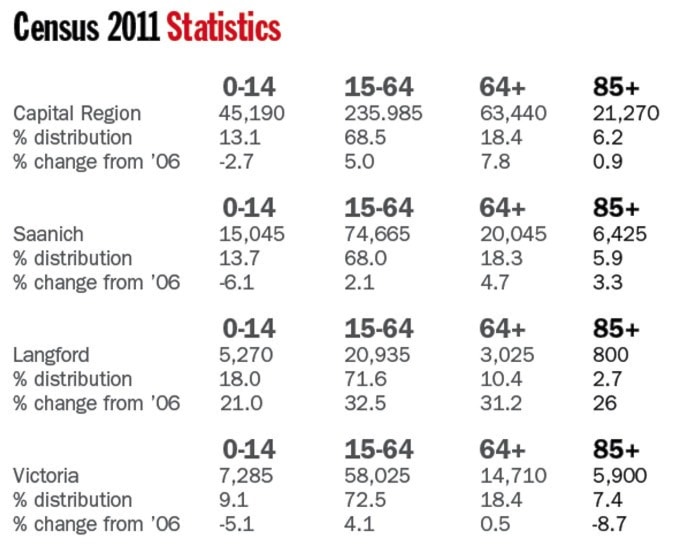Greater Victoria’s population is getting older and there’s fewer kids, a trend that will surprise few and was re-enforced by Statistics Canada census data released this week.
The number of people aged 65 and older has increased by nearly eight per cent in the past five years and is the fastest growing age cohort in the region.
Nearly a quarter of all people in Greater Victoria are senior citizens. The number of youth dropped by nearly three per cent – kids 14 and younger make up 13 per cent of the city’s residents.
The drop in youth is seen almost across the board – the number of kids in Saanich dropped by six per cent and the City of Victoria went down by five per cent. Langford, the only area of the city experiencing strong overall population growth, bucked the trend. The number of kids grew by an astonishing 21 per cent in five years.
Silver Threads, a non-profit service provider for seniors in Victoria and Saanich, is seeing a trend toward seniors on the older end of the scale, said Susan Brice, director of the Victoria office.
“The increase in the number of seniors we’ve known would be coming for some time,” said Brice, a Saanich municipal councillor. “What’s amazing is the number of older seniors at our centres. A large portion is over 85. Many are in their 90s.”
The aging generation of baby boomers is adding to the rise in the number of seniors, as is improved medical care and healthier lifestyles. Once consequence is that more people traditionally at retirement age are seeking employment, either to keep active or because pensions and savings aren’t enough. That’s a phenomenon they didn’t see 20 years ago, Brice said.
Some people who retire to Victoria face sticker shock when it comes to real estate and cost of living, she noted. Silver Threads, especially the downtown facility, helps seniors craft resumes and hunt for jobs, tasks many haven’t done for decades.
“Either by choice or by need, more seniors are remaining in the workplace,” Brice said. “A lot don’t envision spending 35 years in a sedentary or relaxed way. A lot like to stay active. Although many need extra money ... there’s a higher cost of living. Money doesn’t go as far.”
Elaine Gallagher, professor emeritus with the University of Victoria Centre on Aging, said the steady proportional increase in seniors has been predicted for years. Senior governments have been slow to respond, but are starting to see the repercussions of a greying population.
As the senior population gets bigger, the more younger people are caring for aging relatives. And a higher proportion of people will be living with Alzheimer’s, dementia and arthritis, Gallagher said.
“These areas will really be a challenge in the future. There are fewer young people to support health care and social care,” Gallagher said.
“And there are other repercussions. Our generation, baby boomers, want a role to play in society. They don’t want to sit back and just golf and fish. They want to be engaged.”
A greying population has caused local governments to reorient how they develop their communities. Taking to account an aging population while planning infrastructure and programs is now part of the standard procedure.
In 2008, Saanich participated in a World Health Organization project to make urban areas more “age friendly,” in co-operation with the Centre on Aging.
In areas with high populations of seniors, Brice said the engineering department installed countdown indicators at crosswalks and longer walk signals.
Recreation centre needed to be mindful of how people with walkers, scooters and wheelchairs would access facilities. The police department is more aware of the kind of scams targeted at senior citizens.
Saanich and the SD61 also joined forces to meld a seniors centre into an elementary school under threat of closing in Cordova Bay five years ago, a move seen as a success in the face of falling enrolment. Kids and seniors even share joint programs.
“That kind of thinking is needed on how we will manage resources with changing demographics,” Gallagher said.
editor@saanichnews.com
